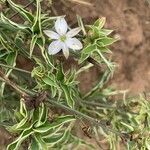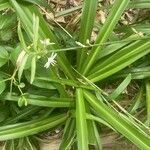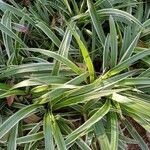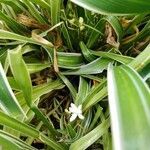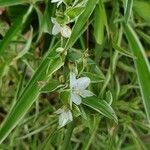A variable complex of plants with ± lax leaves and peduncles, sometimes drying blackish.. Rhizome short, vertical or sometimes horizontal with elongated internodes; roots ± spongy, often with spindle-shaped tubers.. Leaves rosulate, petiolate or not, lanceolate to strap-shaped, usually glabrous, 10–60(–100) cm. long, 1–3(–4) cm. wide, sometimes with scabrid margin.. Peduncles often more than one to a plant, 5–20(–50) cm. long, erect to ± drooping, glabrous to scabrid, with a few sterile bracts just below the inflorescence.. Inflorescence 10–50(–75 cm.), usually simple, sometimes ± paniculate; rhachis sometimes somewhat scabrid, internode elongation varies considerably giving dense to extremely lax inflorescences; floral bracts 5–20 mm., acute to acuminate.. Small plantlets often produced from the bracts of the inflorescence (pseudovivipary).. Pedicels articulated in upper half, 4–10 mm. long, slightly reflexed during anthesis, erect in fruit, 2–4-nate at the lower nodes.. Perianth slightly urceolate, whitish, often keeled greenish outside and apically; tepals patent to somewhat reflexed at anthesis, 4–7 mm. long, 2–3 mm. wide, 3-veined, with scabrid margins.. Stamens exserted; filaments fusiform, dilated above the middle, scabrid to papillose, 3–5 mm. long, longer than the 1–2.5 mm. long, versatile anthers.. Style straight, as long as the stamens.. Capsule triquetrous to deltate, emarginate, usually somewhat broader than long, 4–9 mm. long, 5–9(–11) mm. wide.. Seeds saucer-shaped, slightly folded, 2–3 mm. in diameter.
More
Tufts to c. 50 cm wide at base; roots tuberous, 5-10 cm long. Leaves 20-45 cm long; lamina 6-25 mm wide; veins not prominent. Inflorescence 30-75 cm long, spreading to decumbent, becoming pendulous; axis branched; clusters 1-6-flowered, most flowers aborting; lower bracts subulate, 5-8 cm long; upper bracts ovate-acuminate, 2-5 mm long; pedicels 4-8 mm long, ascending. Perianth green to white; segments 6-9 mm long, hooded, 3-nerved. Sepals boat-shaped. Petals elliptic. Filaments 3-5 mm long; anthers c. 3.5 mm long. Ovary c. 2 mm long; style 3-8 mm long. Capsule less than 1 cm long; pedicel 10-12 mm long. Seeds flat or angular, 2-3.5 mm wide; testa granular-tuberculate, black, dull.
A herb that keeps growing from year to year. It grows 30 cm high and spreads 50 cm wide. The stems are erect and slender. They are wiry and arches over. The leaves are long and like straps. They are at the base of the plant. They have yellow and green stripes. The flowers are small and white.
